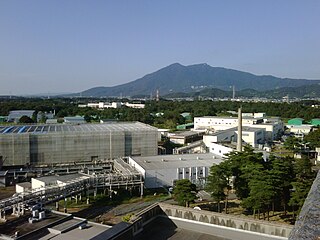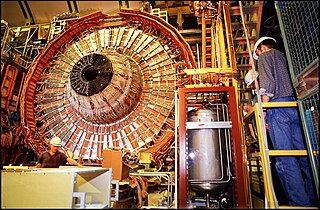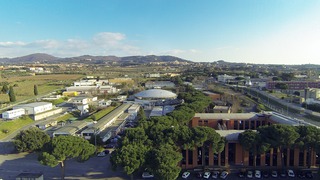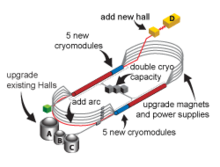
SLAC National Accelerator Laboratory, originally named the Stanford Linear Accelerator Center, is a federally funded research and development center in Menlo Park, California, United States. Founded in 1962, the laboratory is now sponsored by the United States Department of Energy and administrated by Stanford University. It is the site of the Stanford Linear Accelerator, a 3.2 kilometer (2-mile) linear accelerator constructed in 1966 that could accelerate electrons to energies of 50 GeV.

TRIUMF is Canada's national particle accelerator centre. It is considered Canada's premier physics laboratory, and consistently regarded as one of the world's leading subatomic physics research centres. Owned and operated by a consortium of universities, it is on the south campus of one of its founding members, the University of British Columbia in Vancouver, British Columbia, Canada. It houses the world's largest normal conducting cyclotron, a source of 520 MeV protons, which was named an IEEE Milestone in 2010. Its accelerator-focused activities involve particle physics, nuclear physics, nuclear medicine, materials science, and detector and accelerator development.

The High Energy Accelerator Research Organization, known as KEK, is a Japanese organization whose purpose is to operate the largest particle physics laboratory in Japan, situated in Tsukuba, Ibaraki prefecture. It was established in 1997. The term "KEK" is also used to refer to the laboratory itself, which employs approximately 695 employees. KEK's main function is to provide the particle accelerators and other infrastructure needed for high-energy physics, material science, structural biology, radiation science, computing science, nuclear transmutation and so on. Numerous experiments have been constructed at KEK by the internal and international collaborations that have made use of them. Makoto Kobayashi, emeritus professor at KEK, is known globally for his work on CP-violation, and was awarded the 2008 Nobel Prize in Physics.

HERA was a particle accelerator at DESY in Hamburg. It was operated from 1992 to 30 June 2007. At HERA, electrons or positrons were brought to collision with protons at a center-of-mass energy of 320 GeV. HERA was used mainly to study the structure of protons and the properties of quarks, laying the foundation for much of the science done at the Large Hadron Collider (LHC) at the CERN particle physics laboratory today. HERA is the only lepton–proton collider in the world to date and was on the energy frontier in certain regions of the kinematic range.

DELPHI was one of the four main detectors of the Large Electron–Positron Collider (LEP) at CERN, one of the largest particle accelerators ever made. Like the other three detectors, it recorded and analyzed the result of the collision between LEP's colliding particle beams. The specific focus of DELPHI was on particle identification, three-dimensional information, high granularity (detail), and precise vertex determination.

The Argonne Tandem Linac Accelerator System (ATLAS) is a U.S. Department of Energy scientific user facility at Argonne National Laboratory. ATLAS is the first superconducting linear accelerator for heavy ions at energies in the vicinity of the Coulomb barrier and is open to scientists from all over the world.

GlueX is a particle physics experiment located at the Thomas Jefferson National Accelerator Facility (JLab) accelerator in Newport News, Virginia. Its primary purpose is to better understand the nature of confinement in quantum chromodynamics (QCD) by identifying a spectrum of hybrid and exotic mesons generated by the excitation of the gluonic field binding the quarks. Such mesonic states are predicted to exist outside of the well-established quark model, but none have been definitively identified by previous experiments. A broad high-statistics survey of known light mesons up to and including the is also underway.
The A.I. Alikhanyan National Science Laboratory is a research institute located in Yerevan, Armenia. It was founded in 1943 as a branch of the Yerevan State University by brothers Abram Alikhanov and Artem Alikhanian. It was often referred to by the acronym YerPhI. In 2011 it was renamed to its current name A.I. Alikhanyan National Science Laboratory.

The Mainz Microtron, abbreviated MAMI, is a microtron which provides a continuous wave, high intensity, polarized electron beam with an energy up to 1.6 GeV. MAMI is the core of an experimental facility for particle, nuclear and X-ray radiation physics at the Johannes Gutenberg University in Mainz (Germany). It is one of the largest campus-based accelerator facilities for basic research in Europe. The experiments at MAMI are performed by about 200 physicists of many countries organized in international collaborations.
T2K is a particle physics experiment studying the oscillations of the accelerator neutrinos. The experiment is conducted in Japan by the international cooperation of about 500 physicists and engineers with over 60 research institutions from several countries from Europe, Asia and North America and it is a recognized CERN experiment (RE13). T2K collected data within its first phase of operation from 2010 till 2021. The second phase of data taking is expected to start in 2023 and last until commencement of the successor of T2K – the Hyper-Kamiokande experiment in 2027.

The NA58 experiment, or COMPASS is a 60-metre-long fixed-target experiment at the M2 beam line of the SPS at CERN. The experimental hall is located at the CERN North Area, close to the French village of Prévessin-Moëns. The experiment is a two-staged spectrometer with numerous tracking detectors, particle identification and calorimetry. The physics results are extracted by recording and analysing the final states of the scattering processes.
CEBAF Large Acceptance Spectrometer (CLAS) is a nuclear and particle physics detector located in the experimental Hall B at Jefferson Laboratory in Newport News, Virginia, United States. It is used to study the properties of the nuclear matter by the collaboration of over 200 physicists from many countries all around the world.
The PANDA experiment is a planned particle physics experiment at the Facility for Antiproton and Ion Research in Darmstadt. PANDA is an acronym of antiProton ANnihilation at DArmstadt.

The LUX-ZEPLIN (LZ) Experiment is a next-generation dark matter direct detection experiment hoping to observe weakly interacting massive particles (WIMP) scatters on nuclei. It was formed in 2012 by combining the LUX and ZEPLIN groups. It is currently a collaboration of 30 institutes in the US, UK, Portugal and South Korea. The experiment is located at the Sanford Underground Research Facility (SURF) in South Dakota, and is managed by the United States Department of Energy's (DOE) Lawrence Berkeley National Lab.

The INFN National Laboratory of Frascati (LNF) was founded in 1954 with the objective of furthering particle physics research, and more specifically to host the 1.1 GeV electrosynchrotron, the first accelerator ever built in Italy. The Laboratory later developed the first ever electron-positron collider: from the first prototype AdA, which demonstrated the feasibility, to the ring ADONE and later on to DAΦNE, still operative today (2022). LNF was also the proposed site of the cancelled particle accelerator SuperB.
Linguang Tang is a Professor of Physics at the School of Science at the Hampton University, Hampton, Virginia, holding a joint position as faculty at Hampton and as Staff Scientist at the Thomas Jefferson National Accelerator Facility. He completed his B.A. in 1977 from Beijing Polytechnic University, Beijing, China, M.S. 1981, from the Institute of High Energy Physics, the Chinese Academy of Science and Technology, Beijing, China, and PhD in 1987, from the University of Houston, Houston, TX, with Prof. Ed V. Hungerford III. His research group is one of the leading groups in the nation in the area of experimental Hypernuclear physics, with mostly retaining leadership (Spokesperson/co-Spokesperson) roles on virtually all hypernuclear experiments at the Hall C or (E08-012/PR10-001) to be conducted in Hall A at the CEBAF accelerator.
Latifa Elouadrhiri is a Moroccan experimental physicist and researcher at Thomas Jefferson National Accelerator Facility studying elementary particle physics and nuclear physics. She has worked significantly with the CLAS collaboration in Jefferson Lab's Hall B, performing 3D imaging of nucleons. Additionally, she is the spokesperson of the Deeply Virtual Compton Scattering (DVCS) experiment, studying Generalized Parton Distributions .

Cynthia E. Keppel is the Hall A and C Leader at the Thomas Jefferson National Accelerator Facility and a Fellow of the American Physical Society. Her research focuses on the quark-gluon structure of the nucleon, while also considering applications of nuclear physics in medicine. She was a founding member of the Hampton University Proton Therapy Institute.

A Totally Hermetic Electron-Nucleus Apparatus (ATHENA) is a proposed experiment at the future Electron Ion Collider (EIC), in Brookhaven National Laboratory, United States.

Volker D. Burkert is a German physicist, academic and researcher. He is a Principal Staff Scientist at the Thomas Jefferson National Accelerator Facility at Jefferson Lab (JLab) in Newport News, Virginia (USA). He has made major contributions to the design of the CEBAF Large Acceptance Spectrometer (CLAS) that made it suitable for high luminosity operation in experiments studying spin-polarized electron scattering.

















